CHOOSING A STYLE

PERSONALISING YOUR SPACE
Painting walls, adding pots and selecting garden furniture that suits your style combine to create a space that feels like home. When deciding on a look for your schemes outside, start by taking a close look at your interior décor and reflecting those images beyond your back door.

Do you live in a space of clean, sharp lines and uncluttered minimalism, or perhaps you prefer a shabby chic look put together with a mix of vintage items that show the patina of age? What do your soft furnishings say about your preferred choice of pattern, colour and texture? Think about these style factors to help clarify what you find visually pleasing and for some pointers on how to proceed outdoors.
Ideally, there should be a seamless flow between inside and out: a well-executed garden improves the view from indoors (pictured above) and vice-versa. You are effectively creating an extension of your home, while also making a green sanctuary where you can retreat from the hustle and bustle of daily life. The furniture and soft furnishings, pots and accessories you choose are the props that will help you to set the scene.
When transforming a small outdoor space, try painting the surfaces, furniture and pots the same colour to create a uniform look that pulls everything together. Use exterior eggshell, gloss or garden stains, which help to protect wood or prevent metal from rusting too. Also look to nature for inspiration. Cloudy blues and off-whites reflect the sky, or try sharp fresh lemon-limes that echo young spring foliage or the subtle grey-greens of mosses and lichens. Damson shades mirror autumn fruits and berries, and the stony, mottled hues of a pile of pebbles and tawny tones of bark and stems provide more colour solutions. Identify which shades will provide the right foil for you so you can decorate a space that echoes the natural world, where you will feel comfortable and secure.
If your planting area is communal or you live in rented accommodation, with no means to personalise your space, then simply paint a series of containers or window boxes in a colour that you like to create your own personal stamp. Or consider making a portable backdrop with waterproofed fabric rather than paint, which you can take with you when you move.
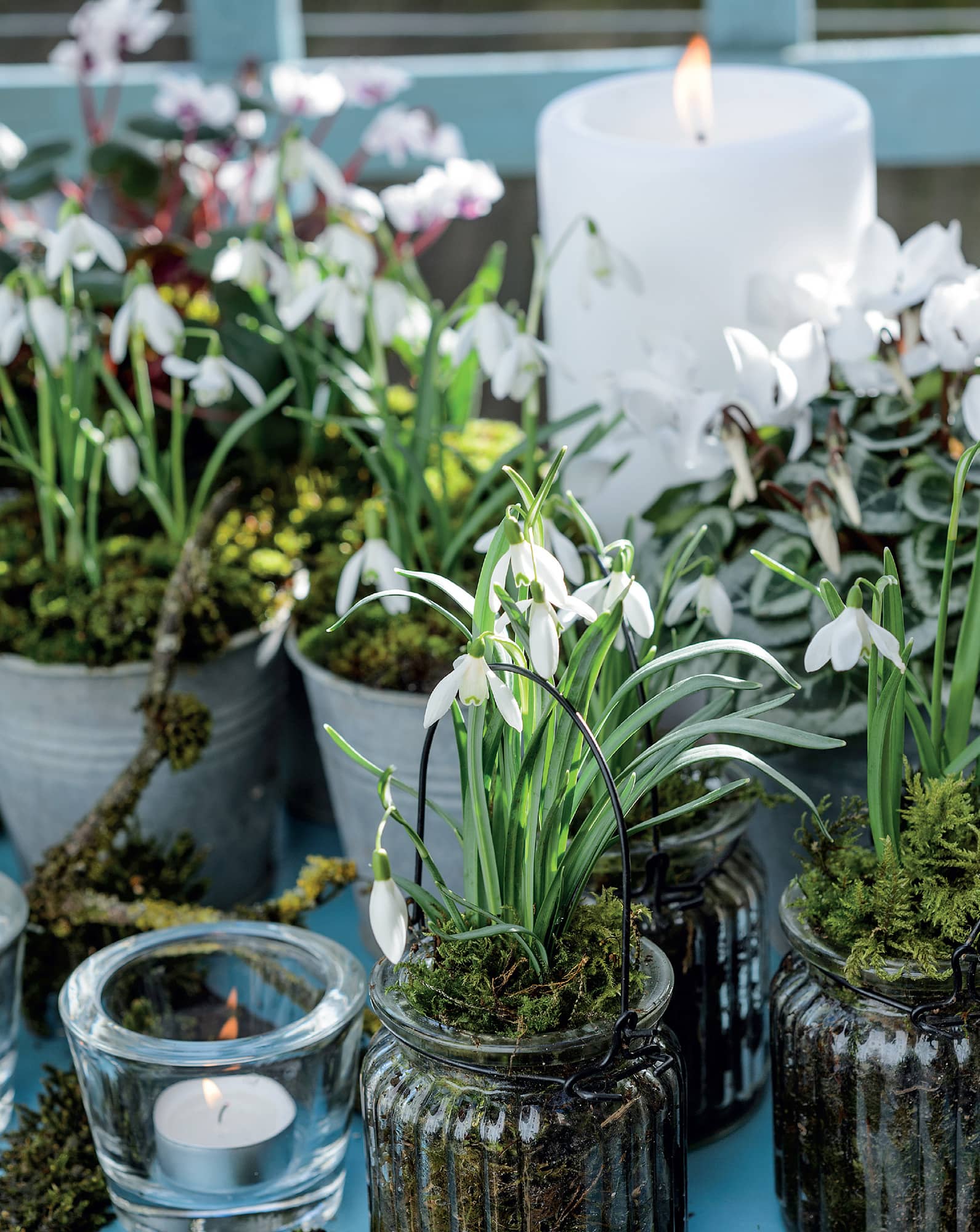
Make a small space your own with natural finds and add seasonal plants in little pots grouped together on a metal table to create a temporary still life.
Sourcing props
To accommodate flowering plants in a tiny space it is not necessary to go out and spend a lot of money on pots and accessories. It’s amazing what you can use with a bit of imagination, a lick of paint and a glue gun. Have a good look around the rooms of your home to see if you already have some containers that would work as planters. Storage boxes, suitcases and trunks, kitchen paraphernalia such as mixing bowls, saucepans or cake tins, empty food cans, and redundant dining china can all be recycled and used as receptacles for your plants. You can plant into almost any kind of container providing you incorporate some means of drainage to prevent waterlogging. This either means drilling or using a nail and hammer to create drainage holes in the bottom of wooden, metal or plastic containers, or adding some small stones, horticultural grit or broken crocks to repurposed china. Kitchen colanders are the perfect planting vessels, given that they have ready-made drainage holes. A mini colander in a bright colour can be planted with a single trailing plant for a quick five-minute project that brings instant joy. Add either macramé or plaited plastic twine before planting and suspend it from a bracket.
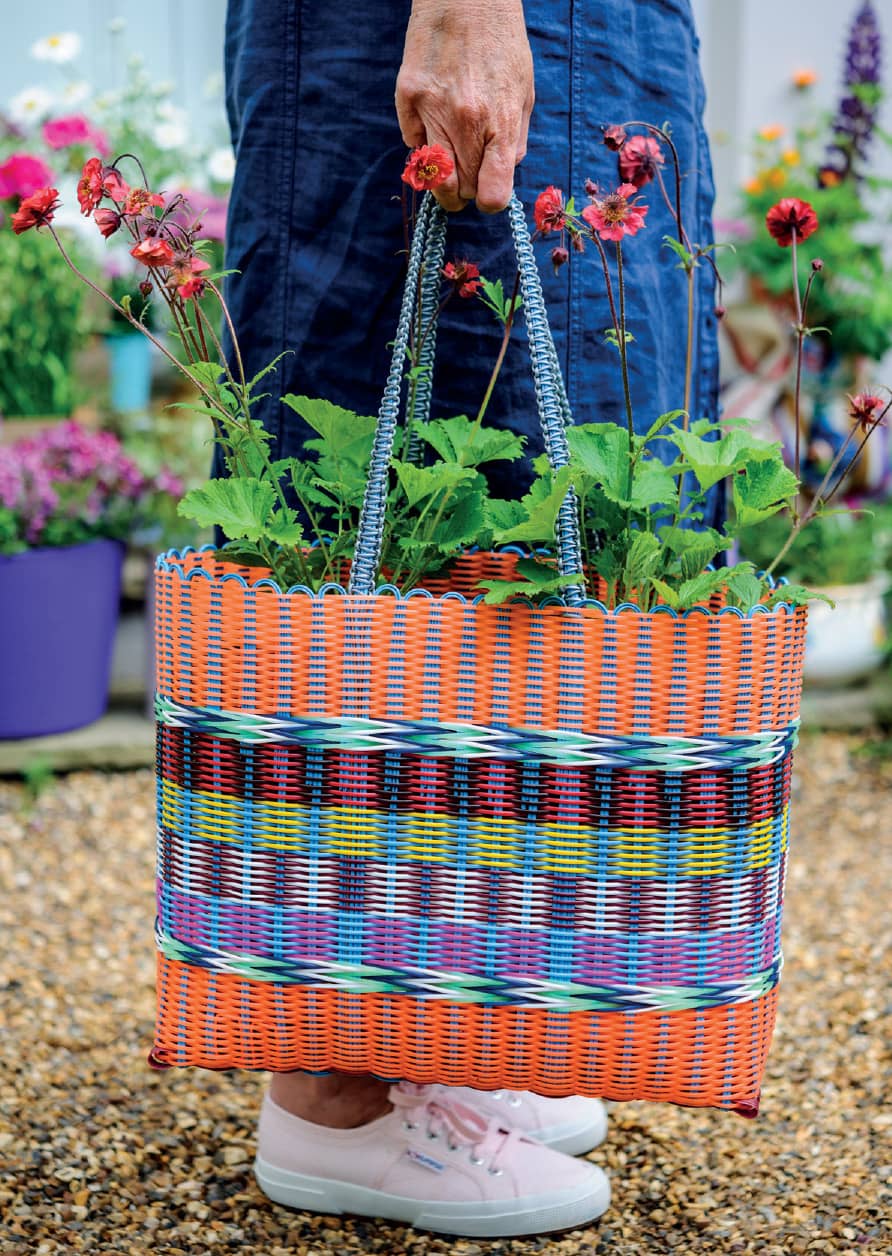
A hard-wearing woven bag made from recycled plastic makes an excellent portable container. Just pop your potted plants inside and cover the top with moss.
From the old to the new
Salvage yards, garage and car boot sales, junk shops and hardware stores often throw up inexpensive finds that can be repurposed for outdoor use. Small wooden pallets that are often available free of charge from garden centres or DIY shops can be dismantled, sanded, reassembled and painted to make shelving, wall planters or trays for seeds. Wooden fruit crates and old wine boxes also fit the bill.
You can customise ugly plastic plant pots by covering them with dried leaves, moss and bark, or use magazine tearsheets to create papier mâché cachepots – a coat of varnish will make them waterproof. Or disguise a large plastic pot with a length of hessian – wrap it like a present and secure with rope. I also use rice or coffee bean sacks in a similar way; you can buy these online. Empty cooking oil drums and catering size tins from fast food outlets can be planted up too, while shopping bags and woven plastic or jute baskets can hide small and medium-sized pots of flowers. Place them inside and cover the compost with sphagnum moss or bark chippings, so that your flowers look as if they are growing in their own self-contained garden.
If you are intending to purchase new props, containers and furniture, look online or visit high street stores or your local garden centre to research the ranges on offer. The choice is endless, so have a clear idea of what you are looking for and stick to it.

Use a fruit crate fixed to a fence or wall to display flowers and artefacts.
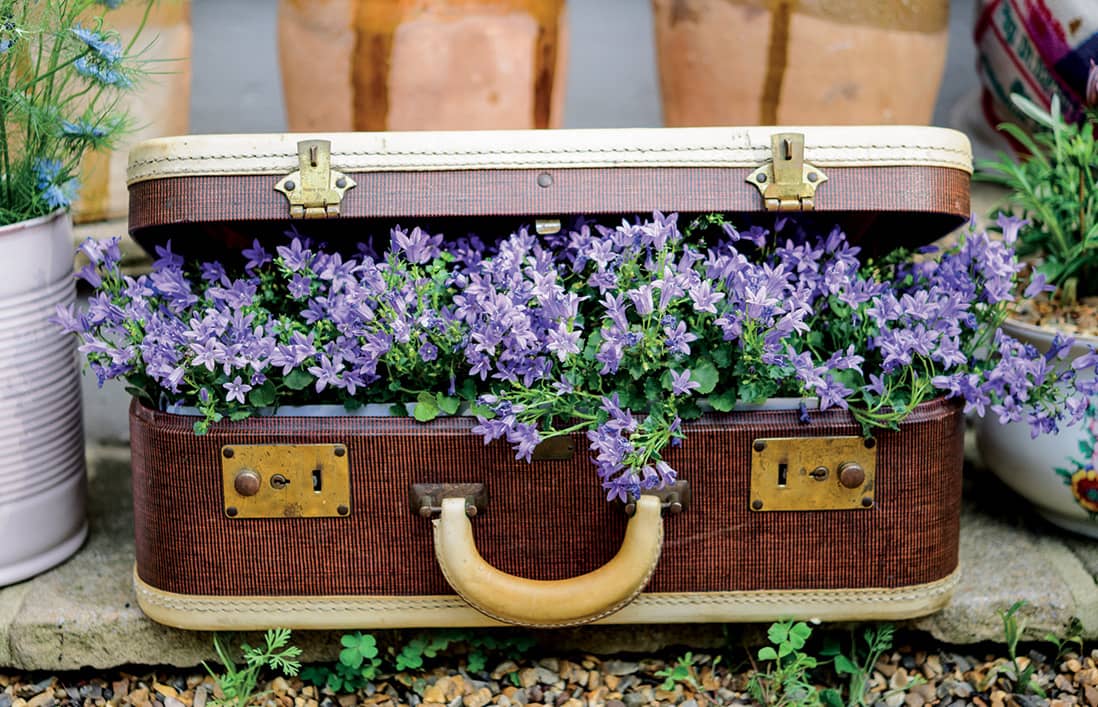
Campanula poscharskyana spills out of a vintage suitcase.
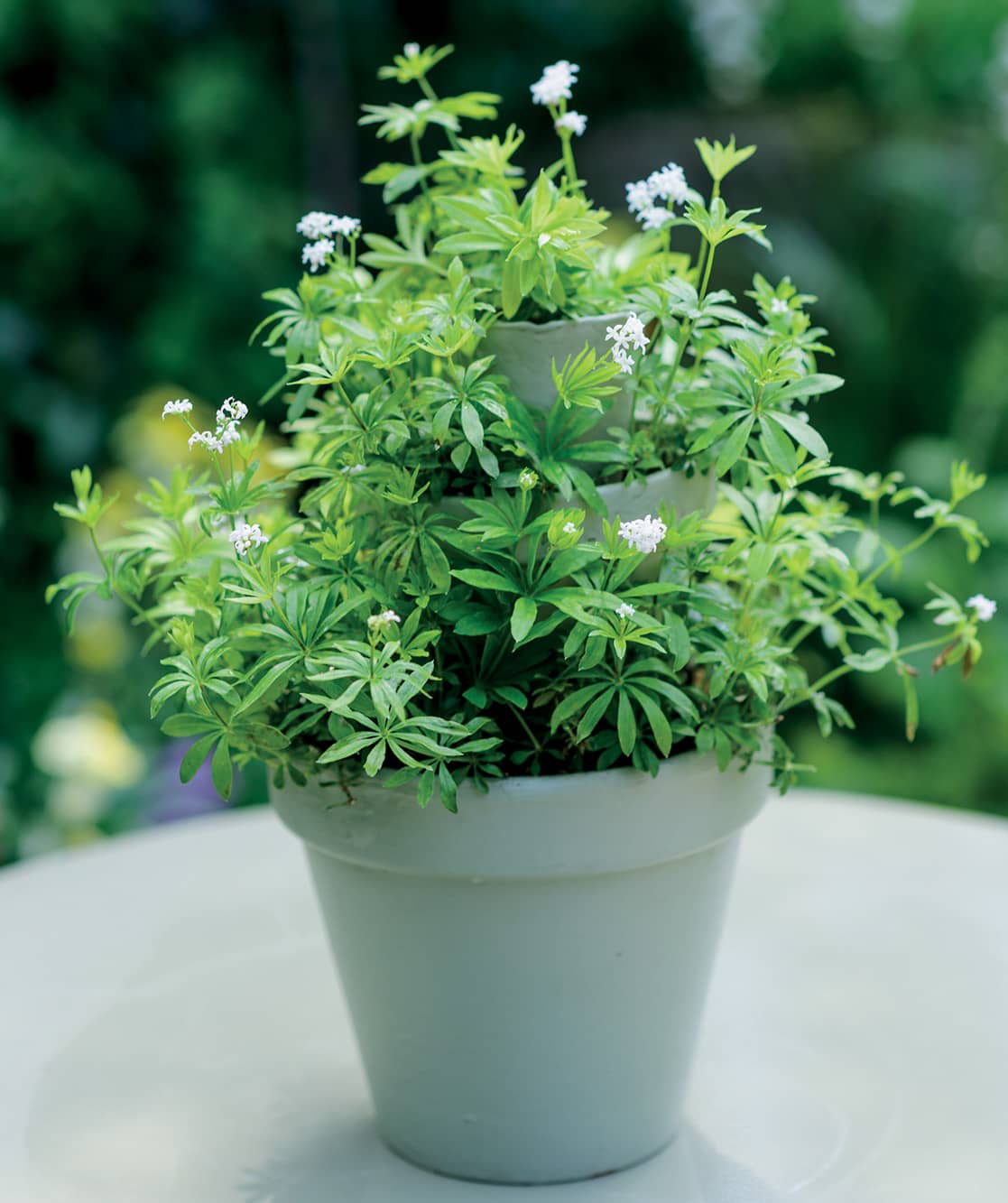
Three pots of different sizes but the same colour are stacked up to make a tiered display.
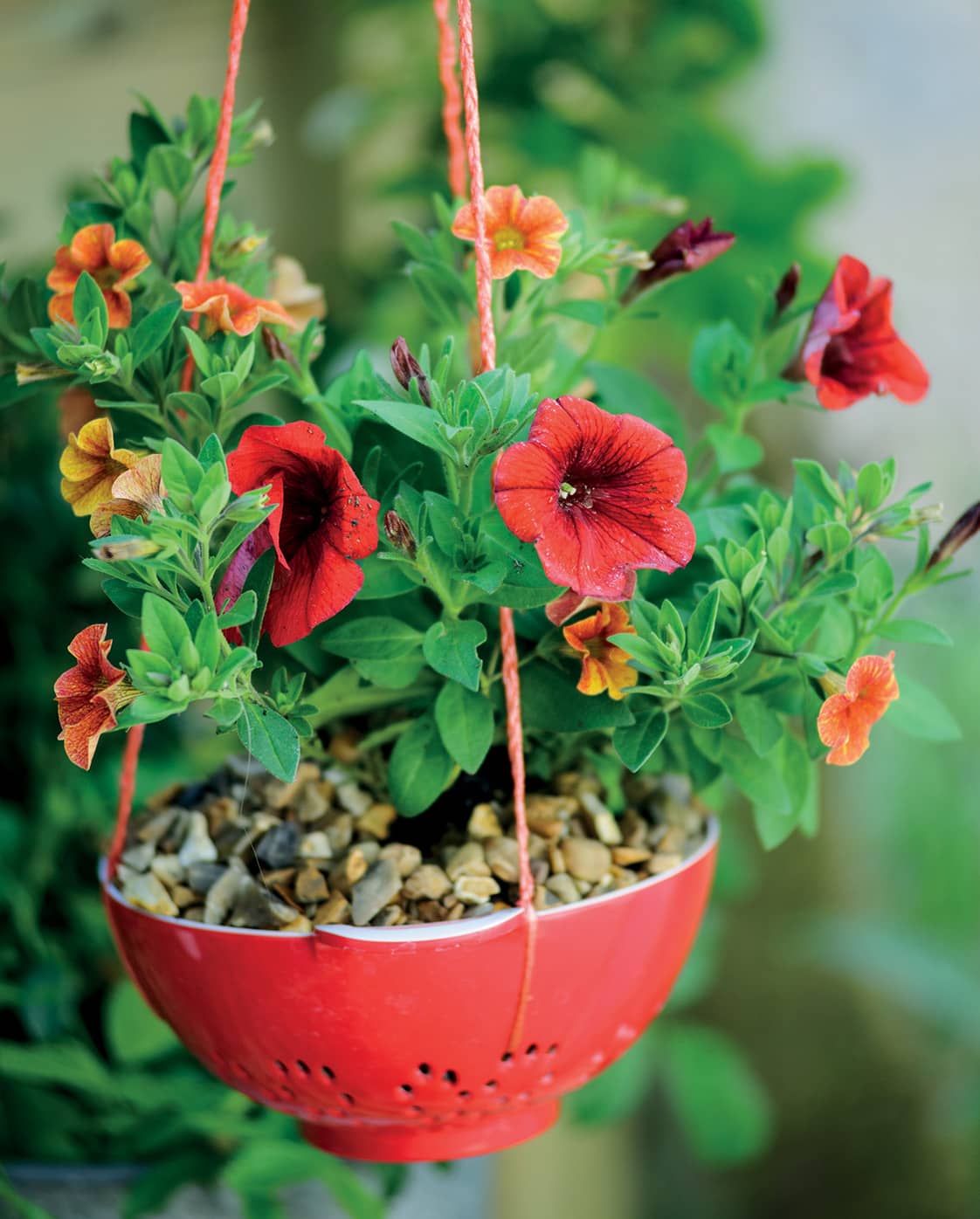
A bright plastic kitchen colander has ready-made drainage holes for trailing petunias.

Create a pretty backdrop with a floral collage behind a wire mesh shelving unit.
DEFINING YOUR STYLE
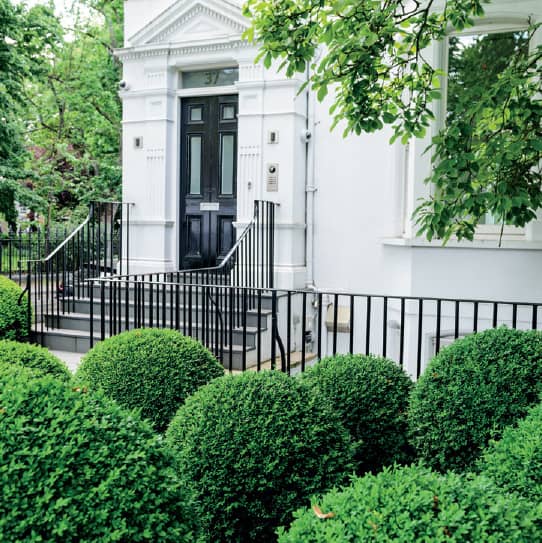
Clipped box balls set the scene for a classic garden style in front of a period London house.
The architectural vernacular of your property will largely dictate the details of your outdoor space, while the city skyline, dominated by tower blocks and punctuated with construction machinery, will inevitably impose itself on your personal space as well.
We cannot borrow from a city landscape as we would in the countryside to create bucolic, far-reaching vistas. Instead, we have to translate and disseminate dreams of a rural idyll and interpret them to create a sense of being at one with nature in our small urban spaces. I have defined three different styles on the following pages that will hopefully allow you to do this.
It is important to note, however, that there are no hard and fast rules, particularly when it comes to plants. It is the way you stage your planting that will dictate your style, rather than the plants themselves. A sense of personal style comes from having confidence in your taste, so pick what you like from my ideas and adapt them to work in your own space.
To source ideas, browse through Instagram and Pinterest, look at magazines, collect wallpaper and fabric samples with patterns of foliage and flowers that jump out at you, and pick up natural finds such as leaves with shapes or textures that appeal to you. Assemble all your chosen images and objects to create a mood board, which will allow you to see how they can come together as a whole. This will also give you a clear sense of direction to follow and allow you to develop your own garden style.
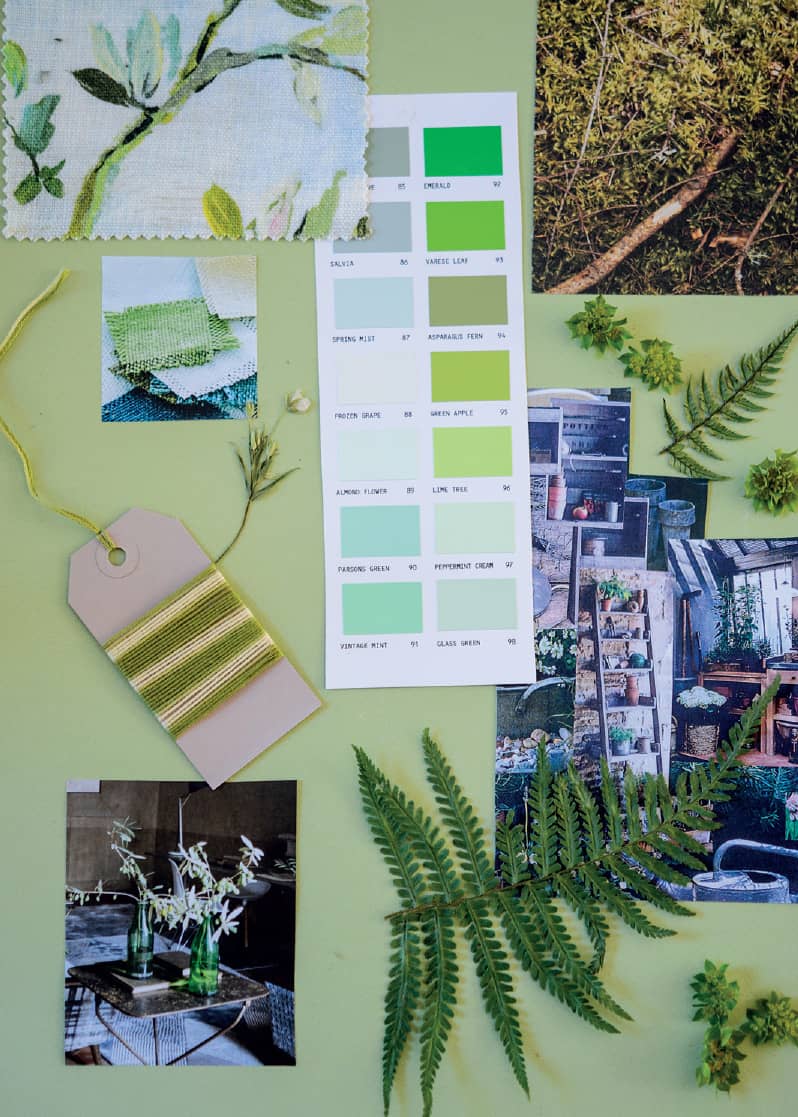
A colour-themed mood board of images and natural finds creates a visual guide and allows you to play around with ideas before committing to purchases.
RURBAN STYLE
The melding of cottage planting and rustic props, this style brings together key elements from country gardens. And while there may not be space for roses to ramble around the front door, it is easy to distill many features into a small urban space.

Metal planters filled with cosmos suit a rurban plot.
Traditionally, the gardens of country cottages are cultivated to be sustainable and productive. Flowers, fruits and vegetables jostle for space in the same bed, and gardeners grow in abundance what they like to cook and eat. The brightly coloured flowers found in these gardens tend to be annuals grown for picking and displaying on the kitchen table, giving to neighbours, or selling as surplus bunches at the garden gate. With space often at a premium, vegetables and flowers are planted in neat orderly rows that can be easily reached for harvesting.
Colourful abundance
At the beginning of the season, cottage gardeners often plant up a small raised bed or defined rectangular patch following a strong linear form. There may be a row of lettuces set out next to a row of beans climbing up wigwam frames; or chard, with its dazzling line-up of rainbow stems, interspersed with vibrant orange pot marigolds (Calendula officinalis) that help to ward off unwanted predators, such as aphids, while also providing food for bees. Neatly clipped mounds of rosemary, thyme and lavender are used to create a textural border enclosing all this bounty. By midsummer the cottage garden is ablaze with colour and full to bursting with an array of edible produce for the kitchen, to be eaten straight away, bottled and pickled, or turned into jam, conserves or syrups.
Adapting a cottage style
While we do not necessarily need to garden in this way for self-sufficiency in the city, cottage style is appealing to many and simple to adapt. Visiting urban allotments will provide plenty of inspiration and ideas. Also look for flowering plants that are closely related to vegetables, such as the cardoon (Cynara cardunculus), a member of the artichoke family, with its large silvery spiny leaves on strong stems that support huge purple thistles in high summer. I plant big cabbages in pots on either side of my front door too – not for eating but for their shape and texture. Other brassicas, such as kale, can also be grown specifically for their looks and striking colours.
Alliums, or ornamental onions, are a cottage garden stalwart which hold their own in the city, with their dramatic purple or white spherical heads, some the size of tennis balls. These pack a punch in a small space and can be grown in containers from bulbs planted in the autumn (see here). If space is very limited try growing chives instead; their flowers achieve the same effect on a smaller scale. Experiment with other flowering herbs, too, such as chicory, borage and sweet woodruff.

The small space in front of this shed allows for a seating area, pots planted with Agapanthus and herbs, as well as a climber clinging to the sides on a trellis frame. The rustic materials and choice of plants provide a perfect example of rurban style.

Use plant supports in a rusty finish to complement your schemes.
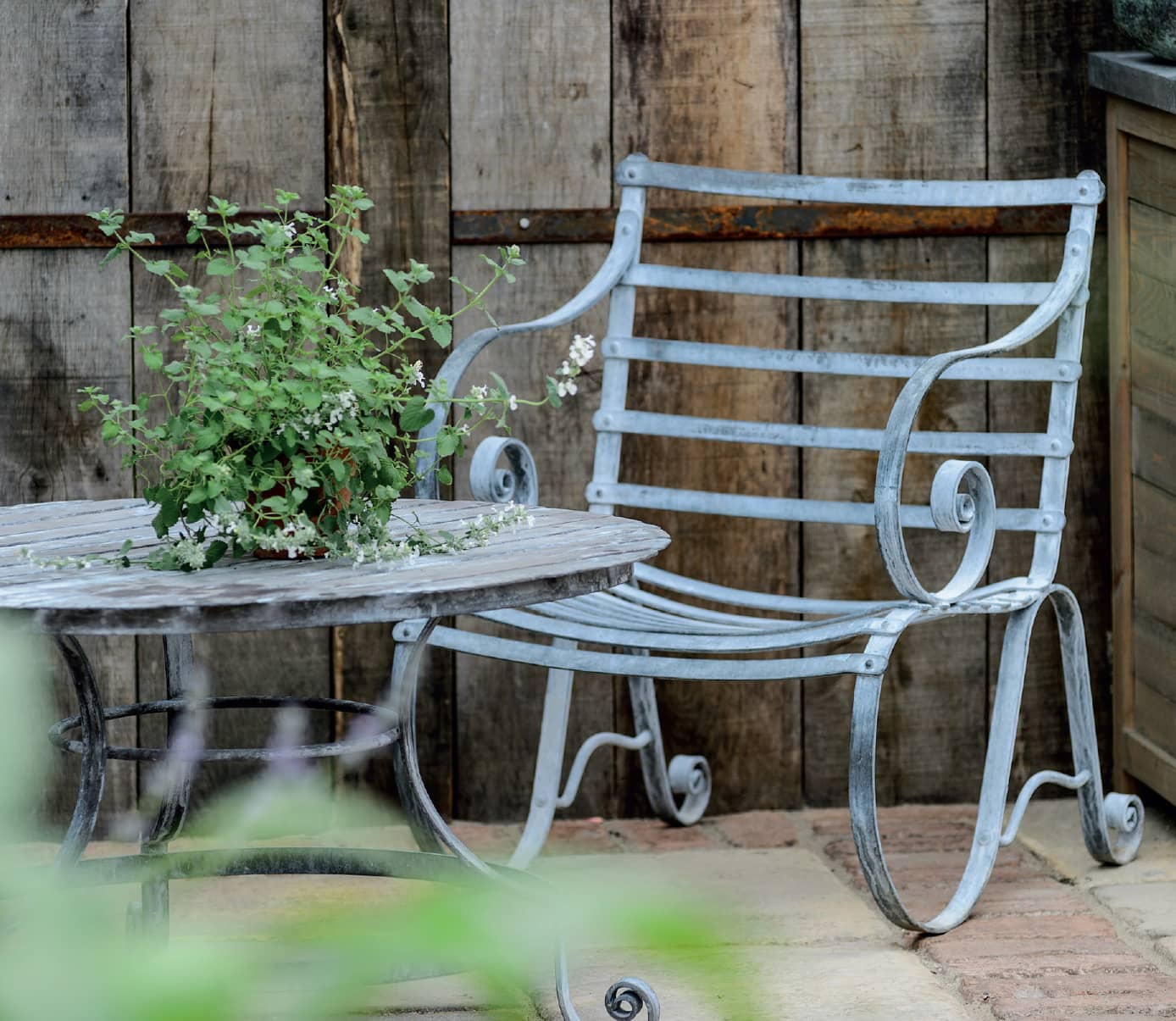
Scour salvage yards and antique fairs for garden furniture.
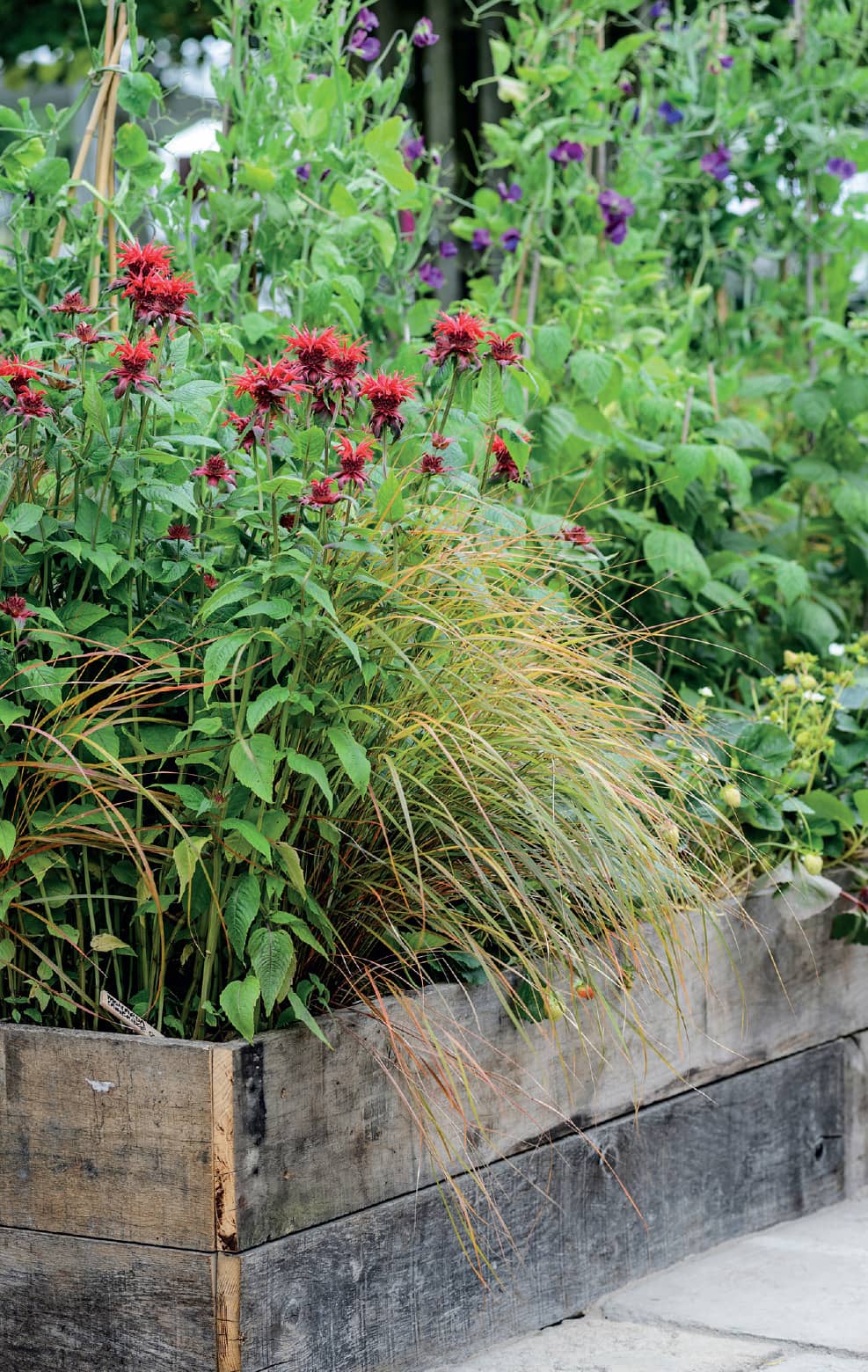
Fill a raised bed with seasonal flowers, such as sweet peas and scarlet monarda.
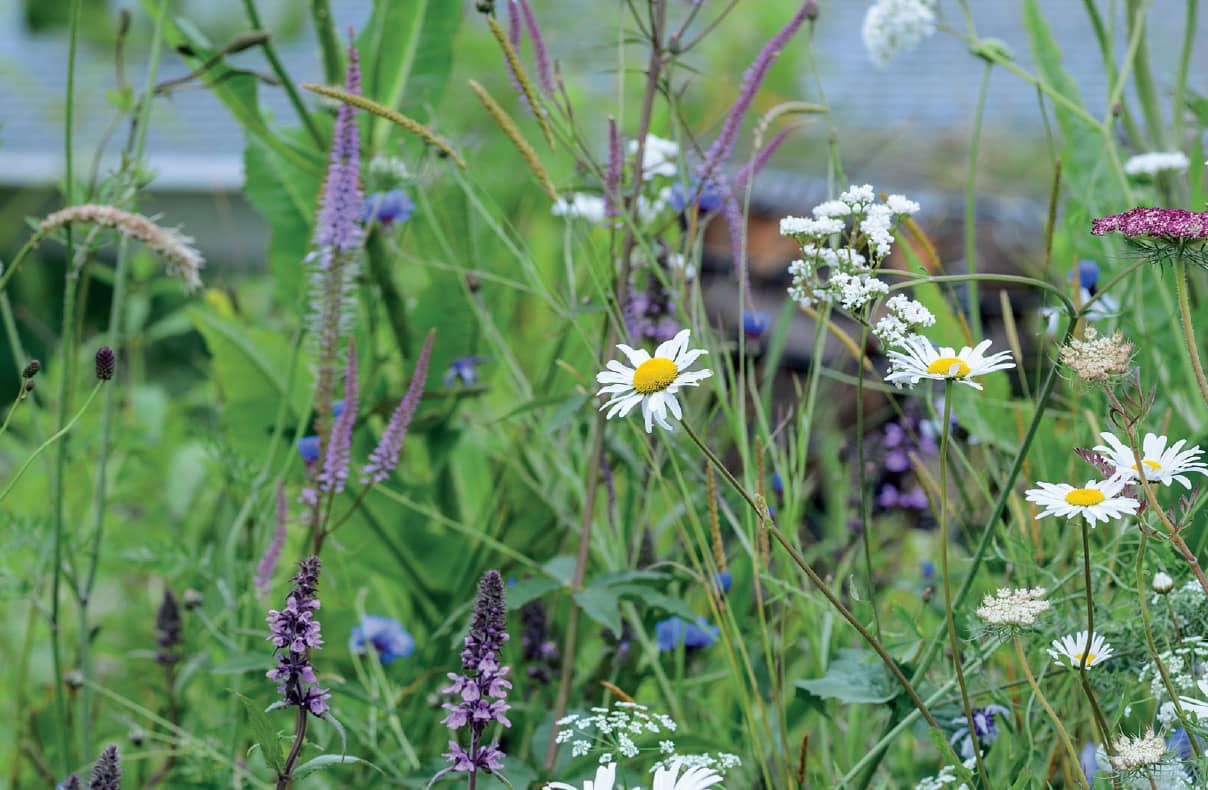
Mix up small planting schemes with wildflowers and grasses grown from seed.
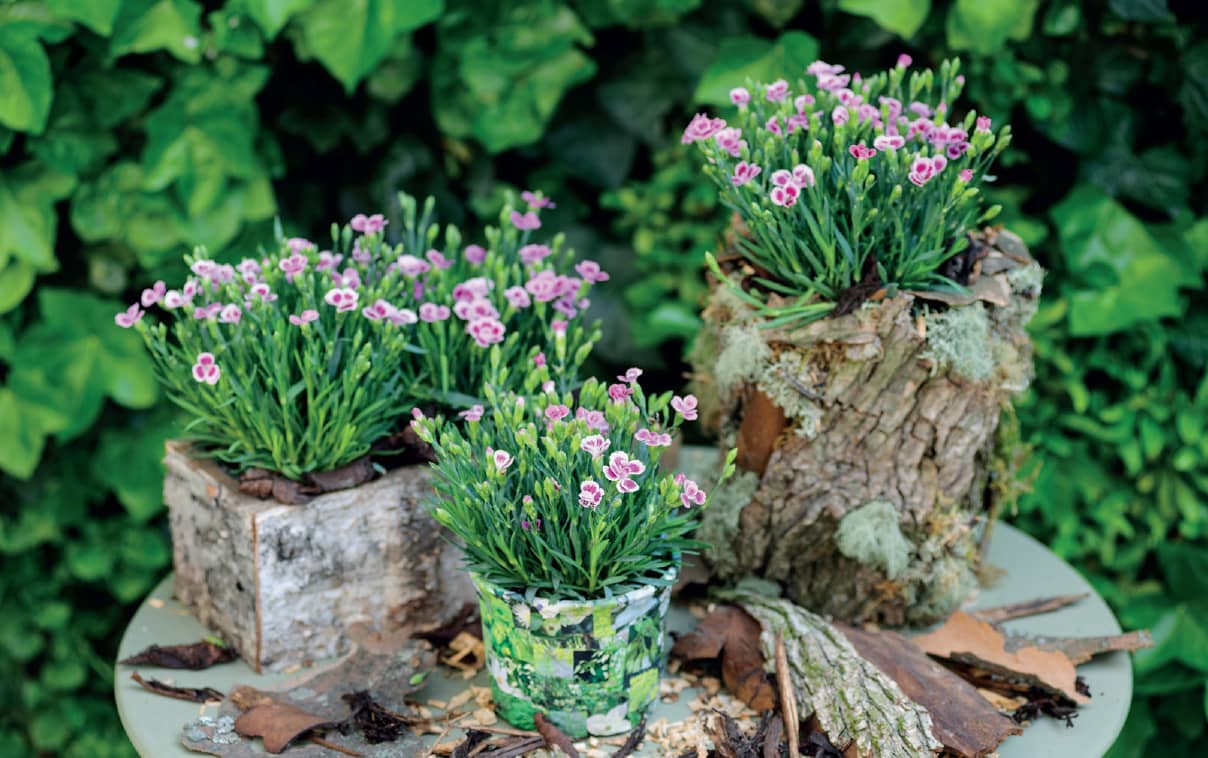
Customise cheap plastic pots by covering them with tree bark or varnished papier mâché.

This naturalistic planting includes cottage garden favourites, such as alliums and aquilegias.
To pretty things up, include the frillier varieties of hollyhocks and a few delphiniums, which will introduce some height and stand tall and upright, while also providing great blooms for cutting. And no cottage garden would be complete without nasturtiums. Among the easiest flowers to grow from seed, both in pots and in the ground (see project shown here), the leaves and flowers are edible, imparting a peppery flavour that will enliven any green salad. Try ‘Black Velvet’ for a sedate dark hue or jazz things up with the bright orange and yellow ‘Tom Thumb’. Sow them alongside cut-and-come-again lettuces or rocket in a window box or crate on your doorstep, and pick as required.
Mixing things up
The rustic element of rurban-styled gardens lies in the props and containers you select. Grow as much as possible in a variety of different-sized pots and containers, where the plants rather than the pots take centre stage. You are aiming for an effortless, artisan look, where everything appears to have been put together by accident, but there is an art to achieving this in a small space without it appearing messy. Firstly, discard anything that is too uniform, new or shiny. Old, hand-thrown terracotta pots in a variety of sizes always look attractive, but if necessary buy new ones, paint them with organic natural yoghurt and leave outside to weather. They will gradually go green and mossy over time. My preferred shape is a tall long tom, which is deep enough to grow delphiniums and hollyhocks without having to stake them. A row of these containers on an urban terrace will immediately summon up the cottage garden aesthetic.

Wrap a large plastic pot in a coffee or rice sack to show off cottage-style plants in a rustic setting.

A stack of hessian sacks used as growing bags make good planters for edible flowers, such as nasturtiums and pot marigolds (Calendula).
Boxed-in displays
Vintage wooden boxes and crates come into their own in rurban-styled gardens. You can find them online or at city flower markets. Alternatively, your local greengrocer will have flimsier versions made of plywood, which can be painted and varnished for planting up outside. The sturdier crates can also be used to make impromptu shelving for pots and containers, if you have space to fix them along your boundaries.
The odd chamber pot, ceramic butler’s sink or glazed clay pot will also look pretty set among wooden crates and filled with herbs or trailing annuals. Use natural jute twine to tie in any tall plants, and include wooden-handled tools, trugs and baskets, cane or rattan furniture and distressed tables and chairs to complete the look.
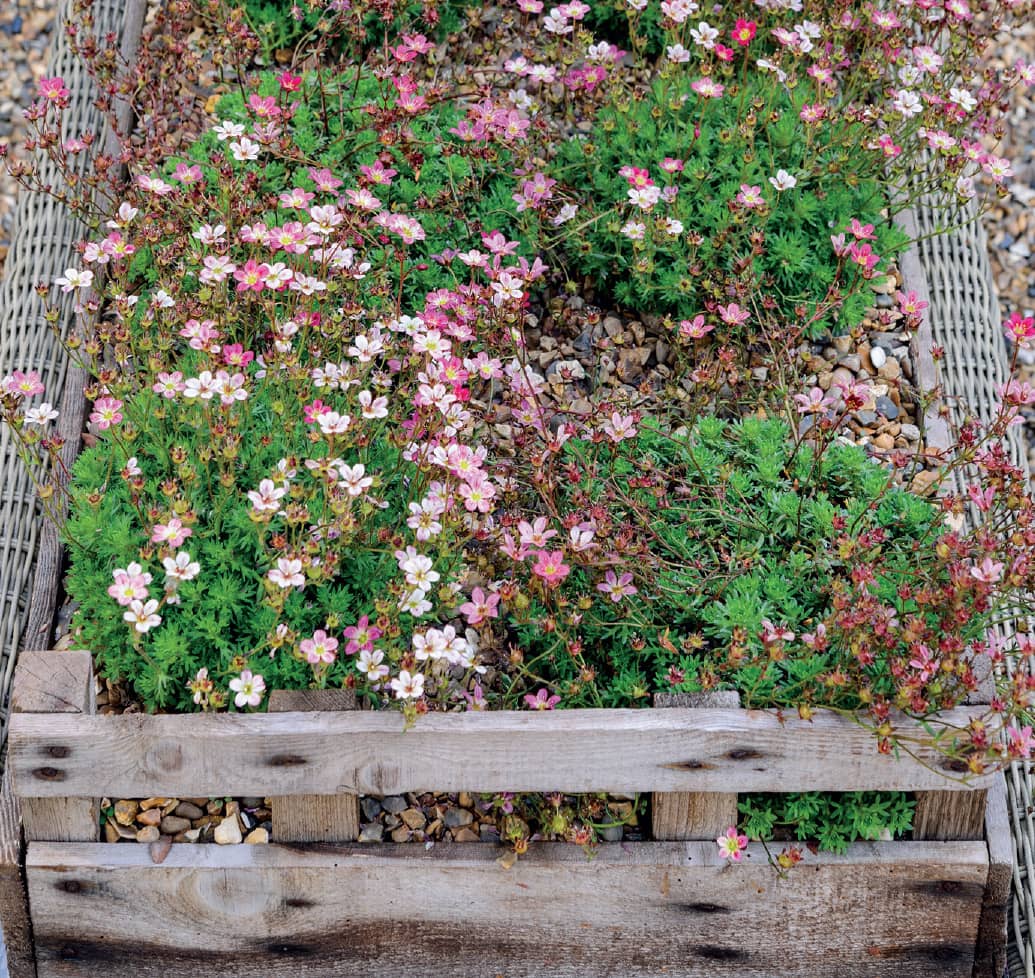
Line a wooden crate with hessian before planting to prevent any soil from falling away. Use plants with shallow rooting systems that quickly form a carpet to cover the surface, such as this saxifrage.
CLASSIC STYLE

The rosette leaf pattern of the Aloe polyphylla plant is an example of the golden spiral. It is a naturally perfect shape that is closely aligned to the golden ratio, which is used a design tool in classic styles.
Classic style never dates. Imparting the elegance and craftsmanship of a bygone era, recreate the look in an urban outdoor setting by researching the design elements of grand period country houses and gardens, and include features that will work on a reduced scale in your city space.
Visiting heritage properties will give you some classical design ideas, which you can then interpret to suit your space and purse. The huge estates of these magnificent houses are often divided into small garden rooms to make them more accessible and to reduce their vast scale. Here, formality, symmetry and the use of correct proportion together impose an overall sense of order. Using pots or planters of the same size and shape, and spacing them equally around a central focal point, such as a fountain, statue or a circular raised bed, will create a similar effect.

A reproduction stone urn immediately sets the scene for classic styling in a small city garden. Filled with Cosmos atrosanguineus ‘Chocamocha’, the dark red flowers smell quite addictively of chocolate.
Classical proportions
A perfect way of working out the measurements for the design of a small classically styled space is to follow the rules of the golden ratio. Also known as the golden mean, the golden section and the golden spiral it is the formula that defines beauty and has been in practice for millennia. It works using a ratio of 1:1.618 and provides designers with the golden rectangle, allowing them to achieve perfectly balanced measurements to work out spatial dimensions, such as parterres, that subconsciously please the eye. Use the ratio as a guide to lay out a small rectangular plot by drawing a square on the ground with chalk. Then use a piece of rope to form a line from the midpoint of one side of the square to an opposite corner. Secure the rope at the midpoint and use it to draw an arc, which will provide the top line of the rectangle, thereby achieving the correct aesthetic proportions.
You can also see the golden ratio employed in art and architecture, but it takes its roots in the natural world. Look at flowers and seedheads and you will see that the petals or pods are in exact proportion to each other in length and diameter; the spiral patterns on pine cones and shells are other examples of nature’s perfection.
Elegant additions
Keeping spacing at the forefront of your mind, consider proportion and shapes while looking for props and furnishings. Source traditional Versailles-styled planters in wood, lead, copper or verdigris. Ideally, purchase two or four in identical or decreasing sizes so you can place them symmetrically. A pair of cast iron or stone urns planted with box balls and set on either side of a doorway looks welcoming and elegant. New stoneware or fibre clay reproductions work just as well. You can also find old stone birdbaths, water basins and other vintage garden items in junk shops and salvage yards. They may be chipped or cracked but can be repaired with quick-dry cement filler, which will be disguised once they are filled with compost and plants. If covered with lichens and moss, rub them gently with a wire brush, but do not try to clean them so that they are immaculate – their age and history is very much part of their appeal.
Traditional glasshouses, orangeries and conservatories offer great styling inspiration too. Search out pictures or visit stately homes for inspiration. You may also be able to visit one of the many restoration projects taking place in city parks in the UK, which are bringing these magnificent structures back to life. If you have the space, a mini greenhouse with a wooden frame can be painted in the same colour as your walls and sets the scene on a tiny scale. If space is even tighter, try sets of domed glass cloches and bell jars, which will not only protect young plants but immediately conjure up images of a Victorian walled kitchen garden. Terrariums also have a classic look. Fill one with moss, small pebbles and miniature plants to evoke the traditional gardening style first pioneered by 19th century plant-hunters, such as botanist James Ward. He invented the Wardian Case for transporting his valuable horticultural treasures on the long voyages back from his expeditions. Use glass containers, jars and vases to customise and create your own Wardian Cases or terrariums, or purchase DIY kits from online companies, who will supply everything you need.

Climbing roses inject a sense of romance to classic formal garden style.
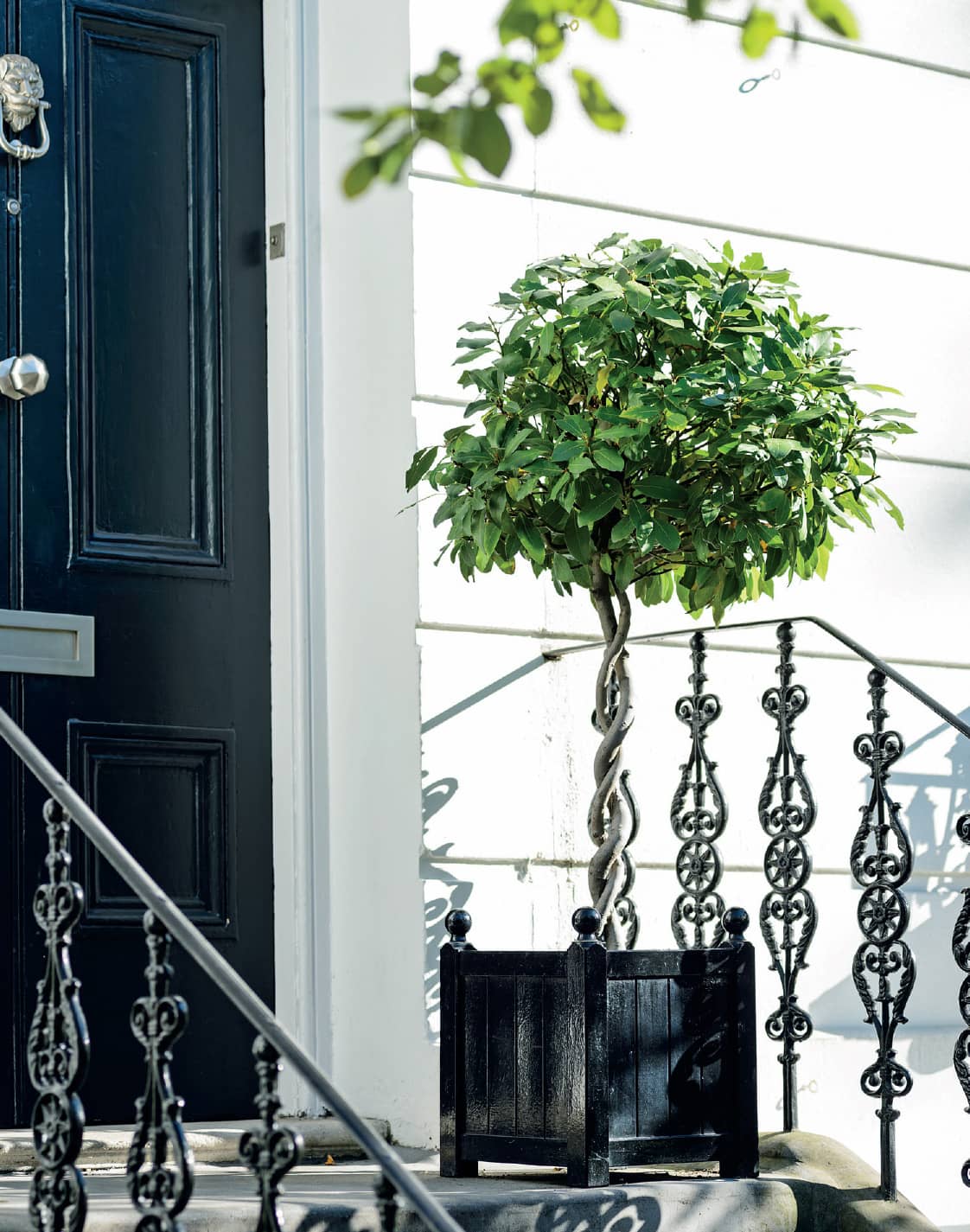
Black planters that echo the colour and style of the front door provide a smart welcome to this elegant home.
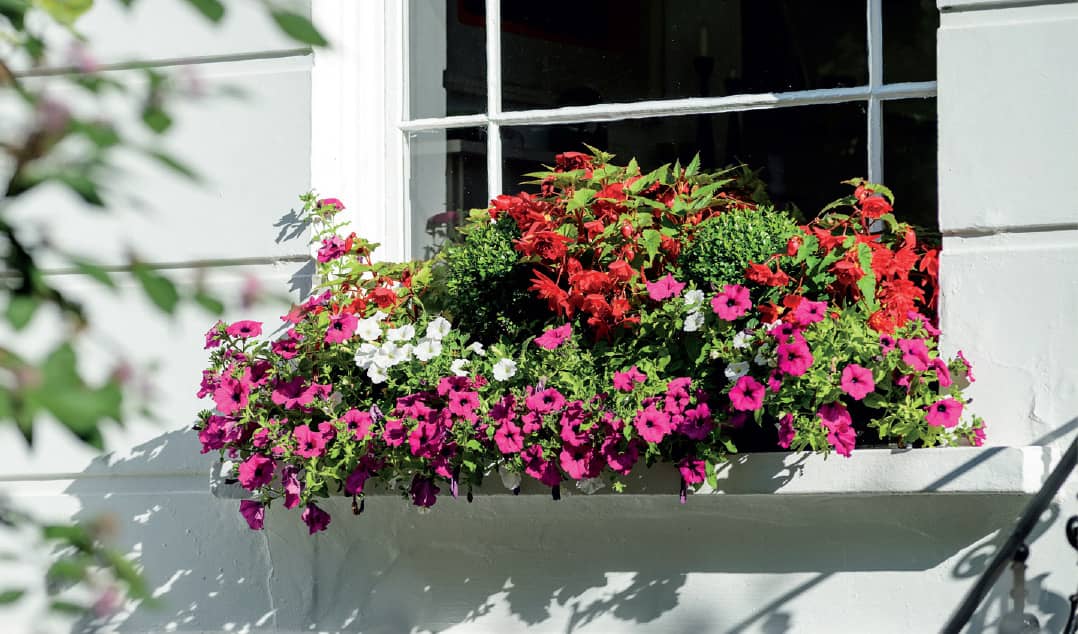
The colourful planting in these traditional window boxes is changed regularly with the seasons.
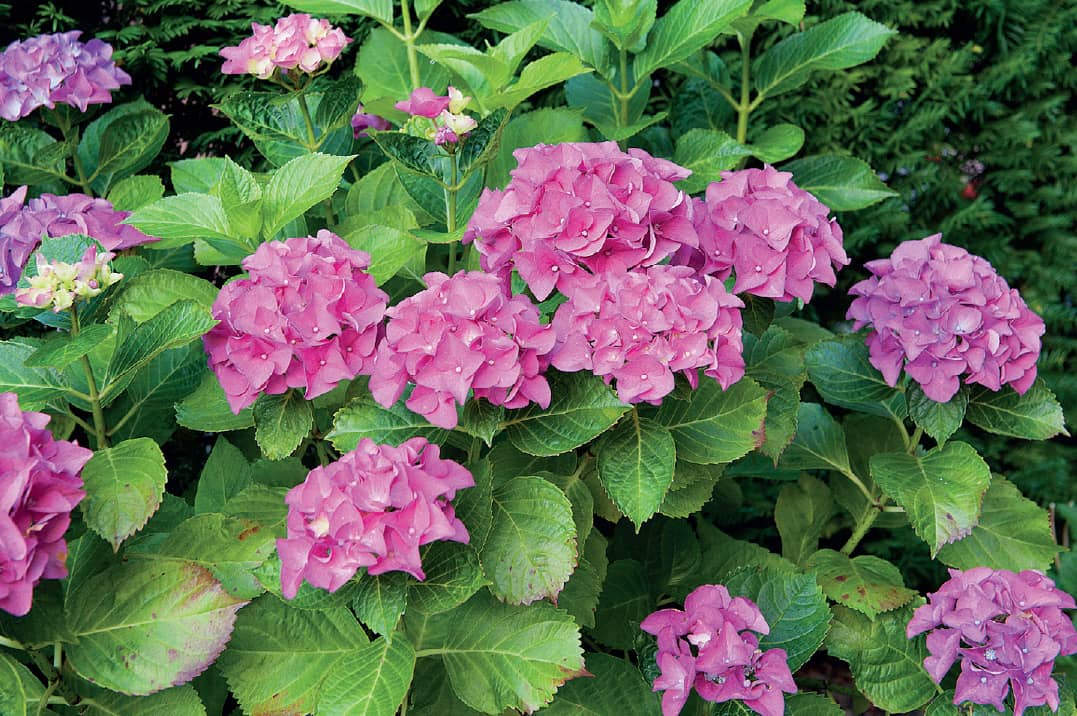
Hydrangea macrophylla makes a strong statement against a clipped yew hedge.
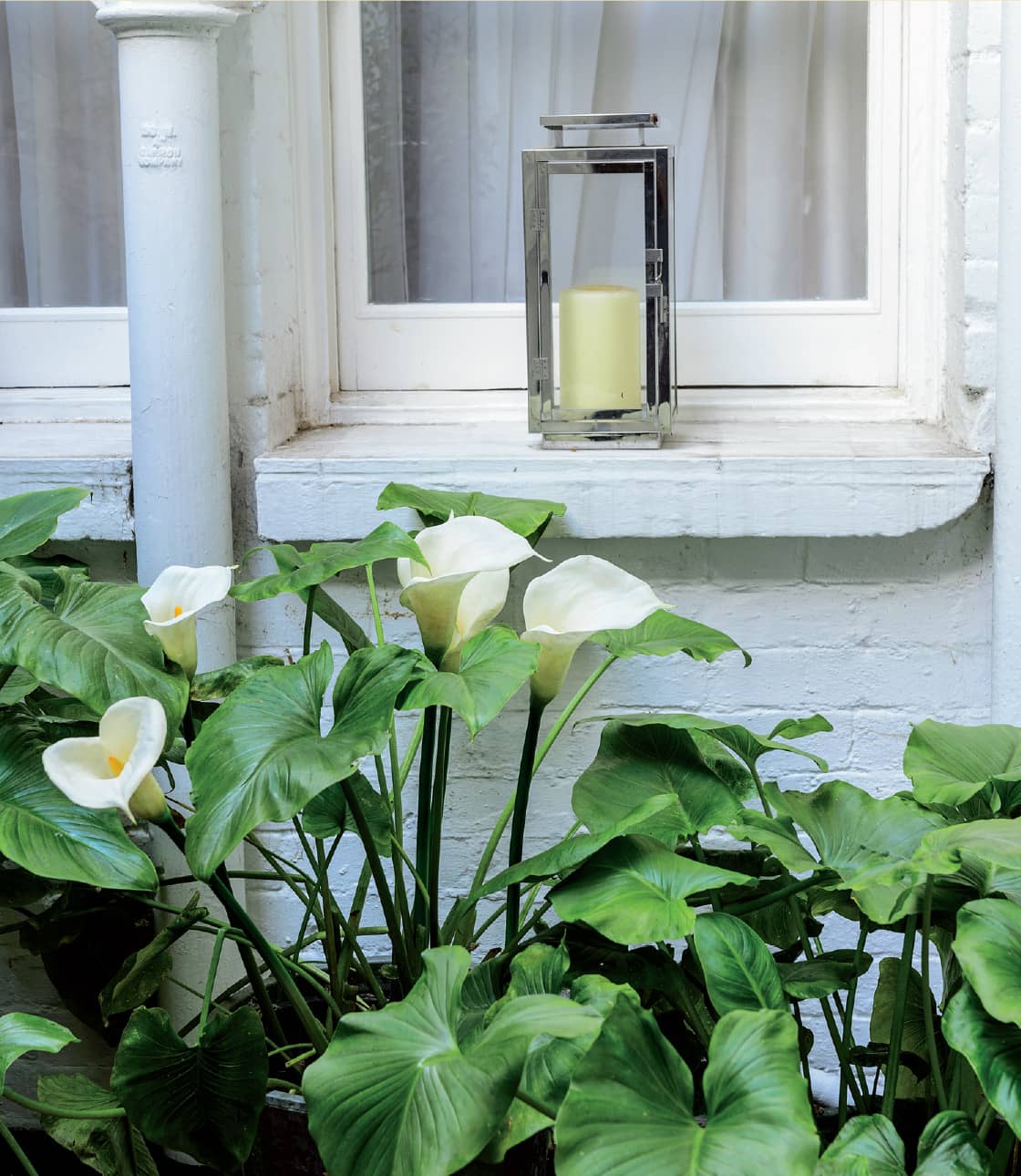
Hurricane lanterns, white paintwork and pots of arum lilies bring a touch of sophistication to a small urban space.

Parterre gardens demonstrate the symmetrical ground plan and orderly planting of the classical style.
Planting for a classical style
To achieve a classic look in beds and borders, grow climbing roses and sweet peas up metal obelisks and install tiered plant stands to display your flowers at different levels on a terrace or patio. A butler’s tray is perfect for the tiniest of spaces and can be used to display a few plants potted up individually, or use the tray itself as a shallow planter for alpines and succulents.
Complete the theme by painting exterior walls and furniture in traditional muted shades. A combination of cast iron or painted metal furniture, and oak trestle tables and benches also help to set the scene. Dress them up with cushions and table linen in faded chintzy fabrics and add a candelabra and glass bowls of cut flowers to create a classic romantic design.

The White Garden at Sissinghurst Castle in Kent in England, designed by Vita Sackville-West in the 1950s, is the epitome of elegant classic style, a look that still looks fresh today.

Copy the original plant hunters and create terrariums in large glass jars to create a set of mini gardens that work inside and out. Ensure you take off the lids or keep them ajar to allow air to enter and escape.
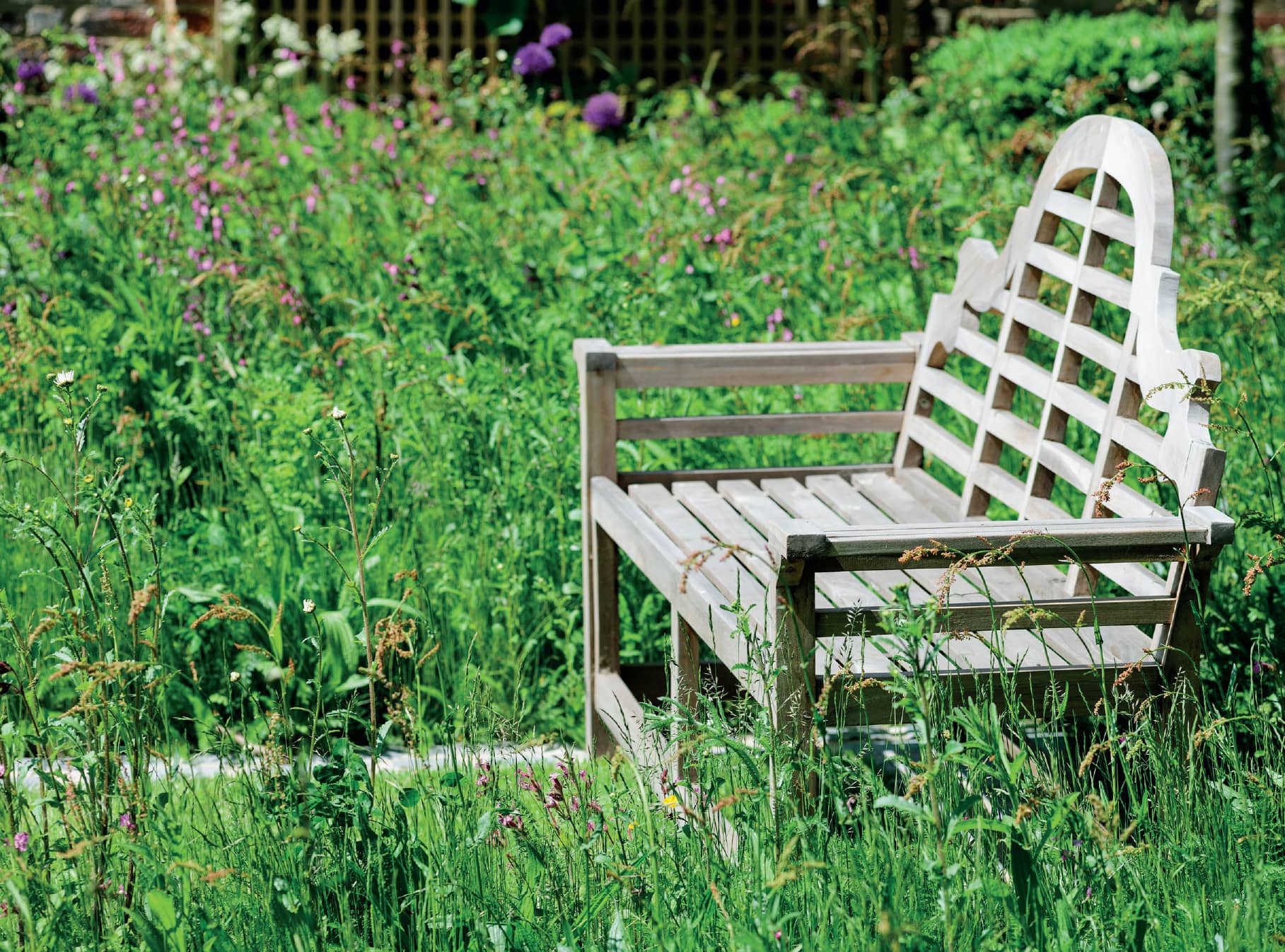
A traditional teak bench in the decorative style of Sir Edwin Lutyens is a permanent investment and will last for years if the wood is correctly cared for.
CONTEMPORARY STYLE

Geometric shapes and modern materials are the key to designing a garden in a contemporary style.
Selecting the props and plants for a modern, of-the-moment outdoor space is quite easy. Stay abreast of current trends, and look at what the big brands in fashion and interiors are doing. Also check out the work of young garden designers at the major annual flower shows.
The gardening style gurus and horticultural taste-makers often follow trends in fashion and interior design, and you can keep your finger on the pulse by doing likewise. Look at the fashion colour of the year as a guide for your garden design if you want to stay on trend.
In contrast to the world of fast, throw-away fashion, however, gardening injects a sense of permanence. It is expensive and impractical to change heavy containers and outdoor furniture every year, but easy to ring the changes with smaller accessories. If you know you are moving on and are only looking for temporary fixes, then a selection of brightly coloured pots, woven plastic baskets and shopping bags will offer an inexpensive yet effective way of injecting modernity into your planting schemes.
Looking sharp
Contemporary style is about clean lines, minimal clutter and the use of asymmetrical geometry. A design laid out on an angle of 45 degrees, for example, can be enough to change the dynamic of a small area. Modern styles are often pared back to the barest bones, and as much attention is given to the hard landscaping as to the plants. Smooth, hewn stone, transparent reinforced glass panelling and horizontal fencing with no obvious gaps or joins all create a seamless look, which can also give the impression of a space looking bigger than it really is.
To achieve a contemporary style, pay attention to the detail. It is important to use high-end, top quality materials throughout. Choose those that do not age too quickly and ensure the execution of any hard landscaping is perfect – any cracks or blisters in joints between paving stones will stand out like a sore thumb.
Pots and containers in materials similar to the hard landscaping add to the effect, with spots of colour introduced through furniture, soft furnishings and accessories. Plastic or melamine furniture comes in a vast array of colours and styles, and it is durable, easy to maintain and light to carry up stairs to balconies and roof terraces. Bold, bright prints on cushion and table linen fabric, and hammered-metal accessories, including tin pots, which can be found in just about every shade, also allow you to mix and match primary colours to achieve an up-to-the-minute, contemporary look.

Concrete planters work well against austere exposed brickwork in this modern space.
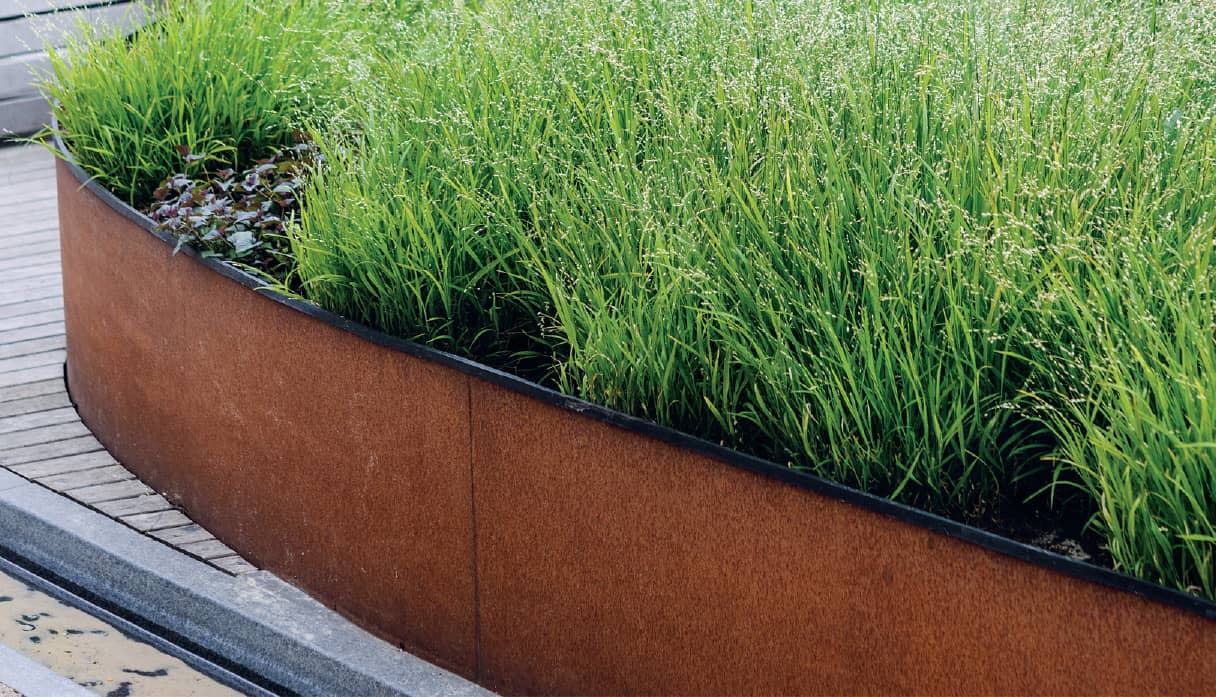
Corten steel is a favourite material of many modern garden designers, chosen for its handsome looks and durability.
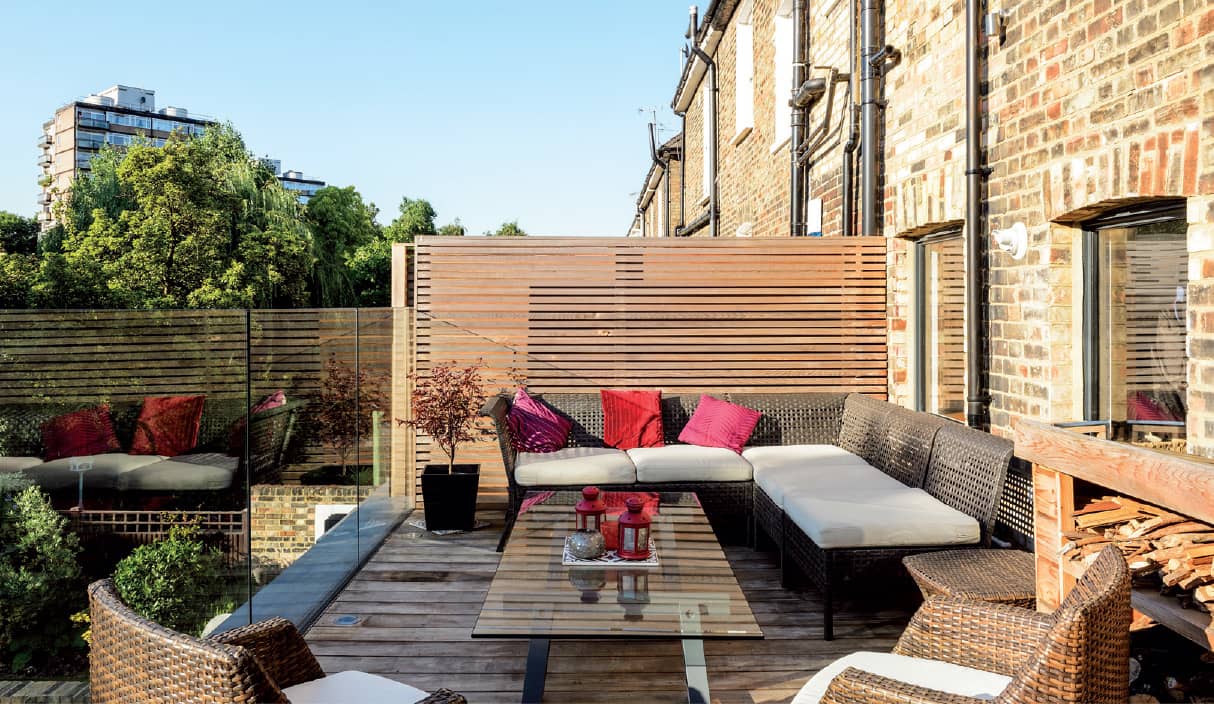
This roof terrace at the back of a townhouse has a minimalist 21st century design.
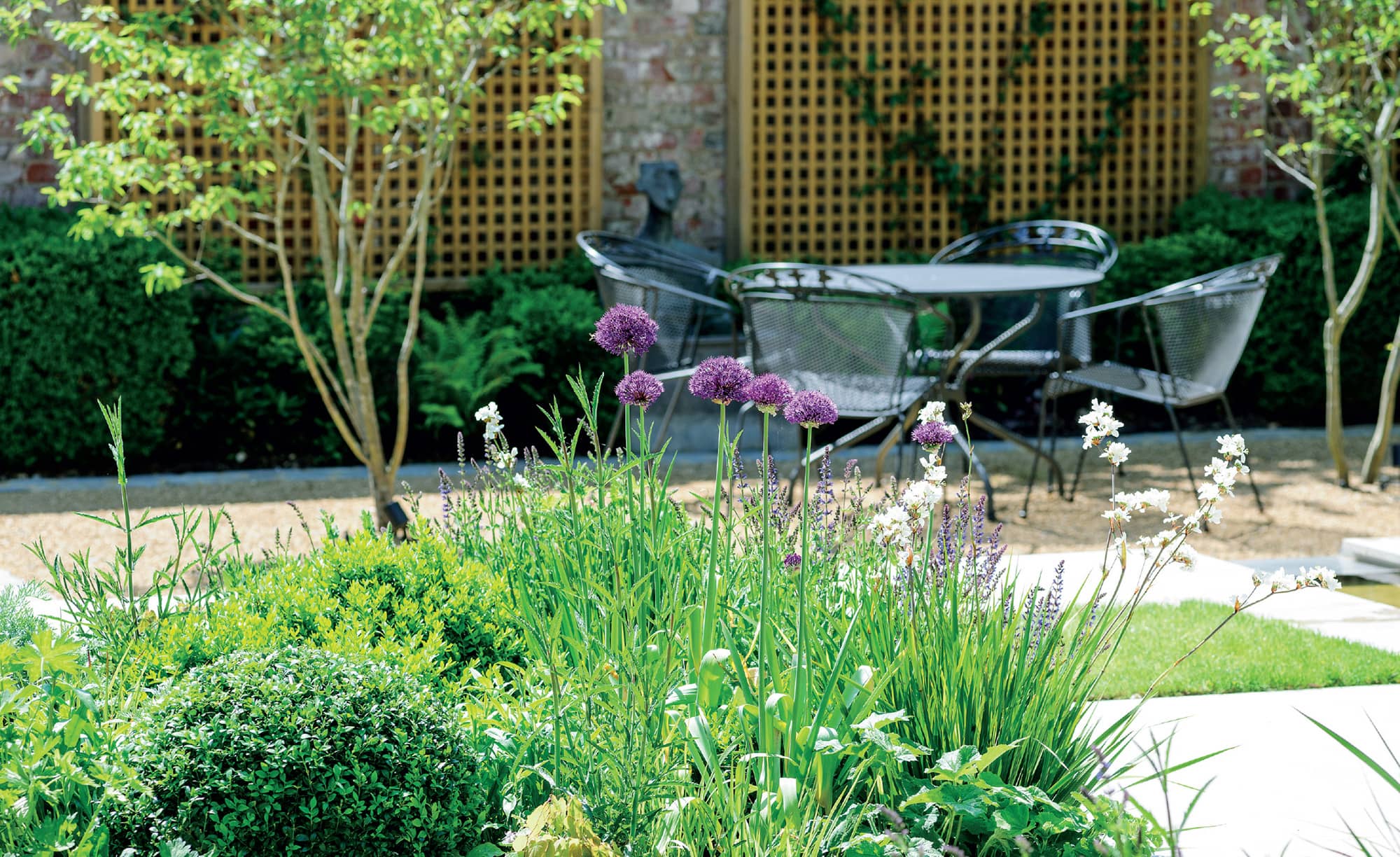
Clean lines, pale stone paving and metal garden furniture are enhanced by the restrained plant palette of mostly greens in this elegant garden.

A sculptural water feature is surrounded by verdant planting which prevents it from looking too stark.
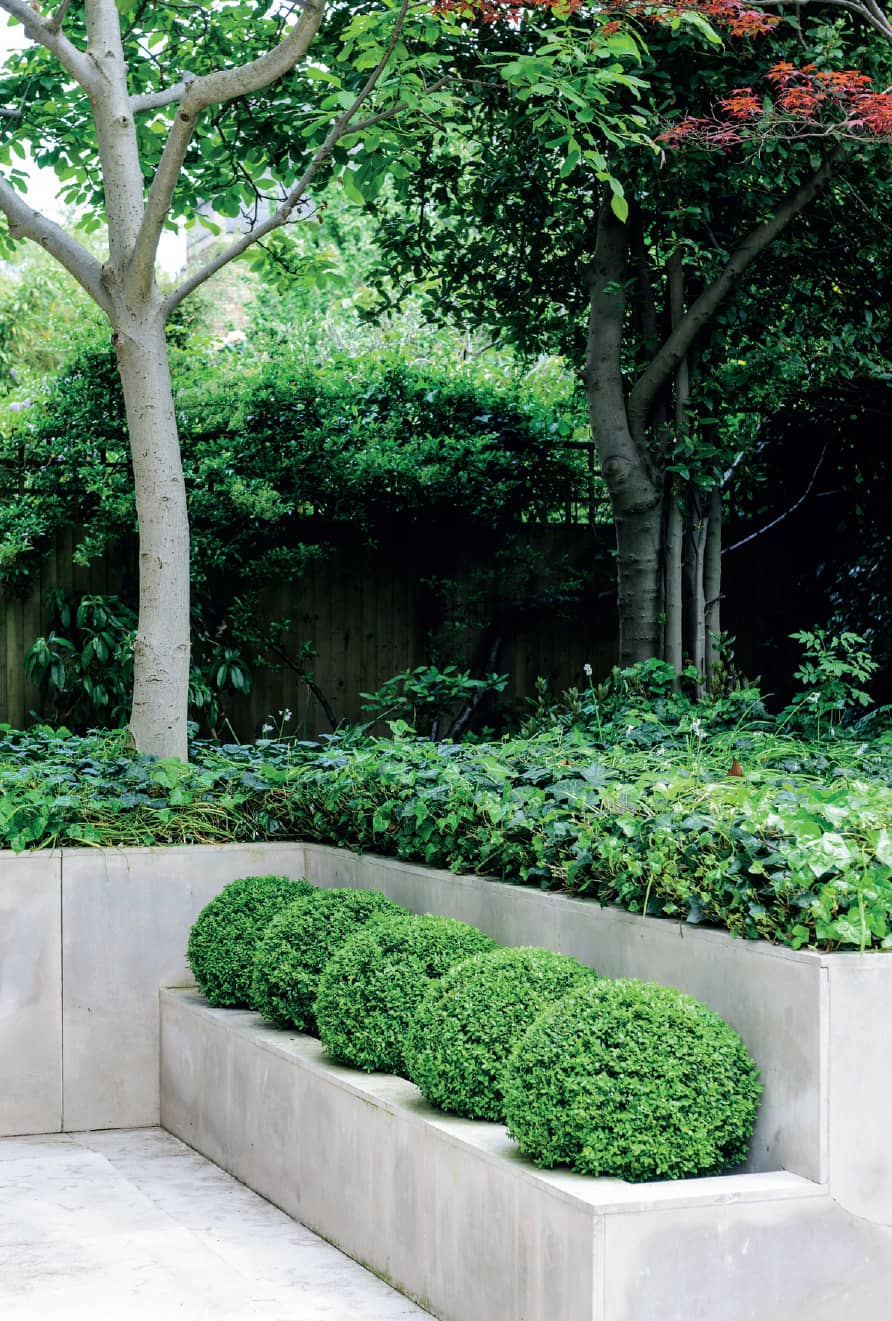
Tightly clipped topiary, such as these box balls, and spotlessly clean paving is key to pulling off a contemporary style successfully.
Industrial aesthetics
If using too much colour feels overwhelming, stick to zinc or corten steel. These materials work particularly well in converted industrial spaces. Former warehouses and factories that have been transformed into new homes lend themselves to a particular aesthetic. Salvaged office furniture will not feel out of place here. Try using metal file boxes and small cabinets on wheels as containers; they can be planted up directly or pot up your flowers in plastic containers that can be dropped into them.
Wire-mesh shelving and wall racks can provide homes for faux-concrete pots, making the most of vertical spaces; ladders do the same job. Outdoor mirrors will help to make a tiny balcony appear larger, and they can be softened with clear fairy lights strung up on invisible wires that reflect in the glass. Also hang LED lanterns from hooks in your flowerbeds to show off the plants at night. Use battery-operated lights if you have no outdoor power supply.

Planted with a mix of evergreens, this street-facing balcony provides year-round interest for both the inhabitants of the apartment and passers-by.
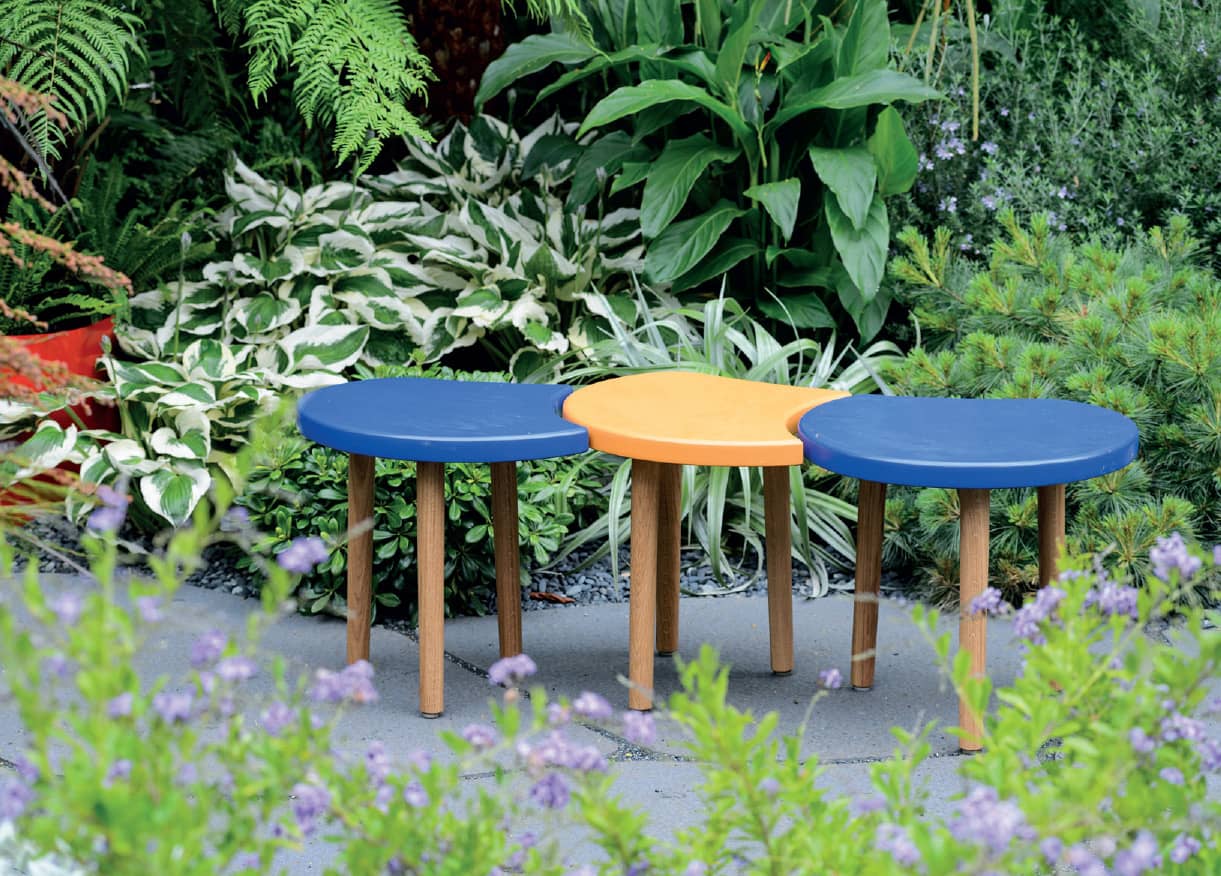
Bold pops of primary colours can be injected into a design through the use of accessories, seating and other furnishings.
Modern planting styles
Architectural plants with a defined shape and form come into their own in a contemporary space. Cloud-pruned topiary makes a modern statement and you can clip almost any small-leaved evergreen shrub or tree into a desirable shape. Also try the large leaves and tall flower spikes of bears’ breeches (Acanthus mollis), which will add drama to a border or deep planter, as will many grasses. Leafy hostas and ferns are perfect for modern containers in shady spaces, their foliage helping to soften the pots’ edges.
If you choose to add colour, try red hot pokers (Kniphofia), available in orange and yellow, and the funnel-shaped scarlet flowers of Crocosmia ‘Lucifer’, which look stunning in oversized planters. For smaller containers, annual zinnias and cosmos come in bright zingy colours, and they are easy to grow from seed. For year-round contemporary planting, succulents are ideal for table-top planters or in vertical schemes, where they will require little maintenance or watering.

Silver-leaved Nepeta and Artemisia are offset by the scalloped foliage of Alchemilla mollis.
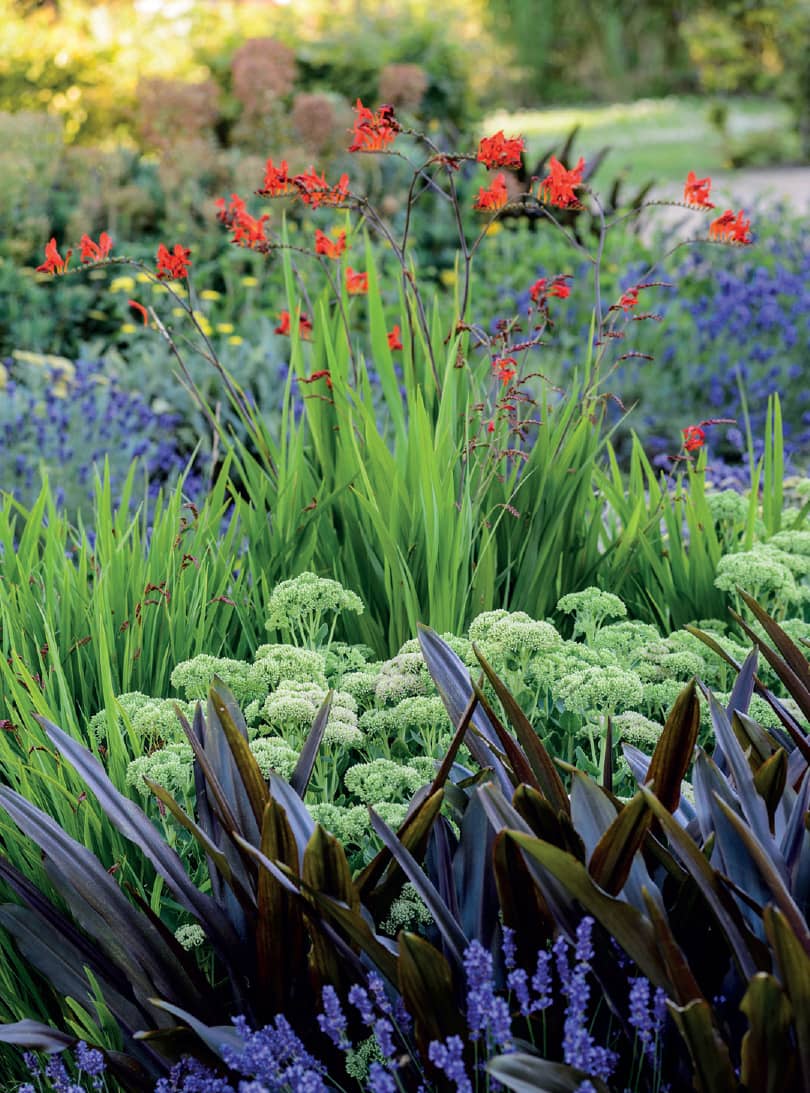
Layers of planting in this modern scheme highlight contrasts in the various plants’ form, colour and texture.
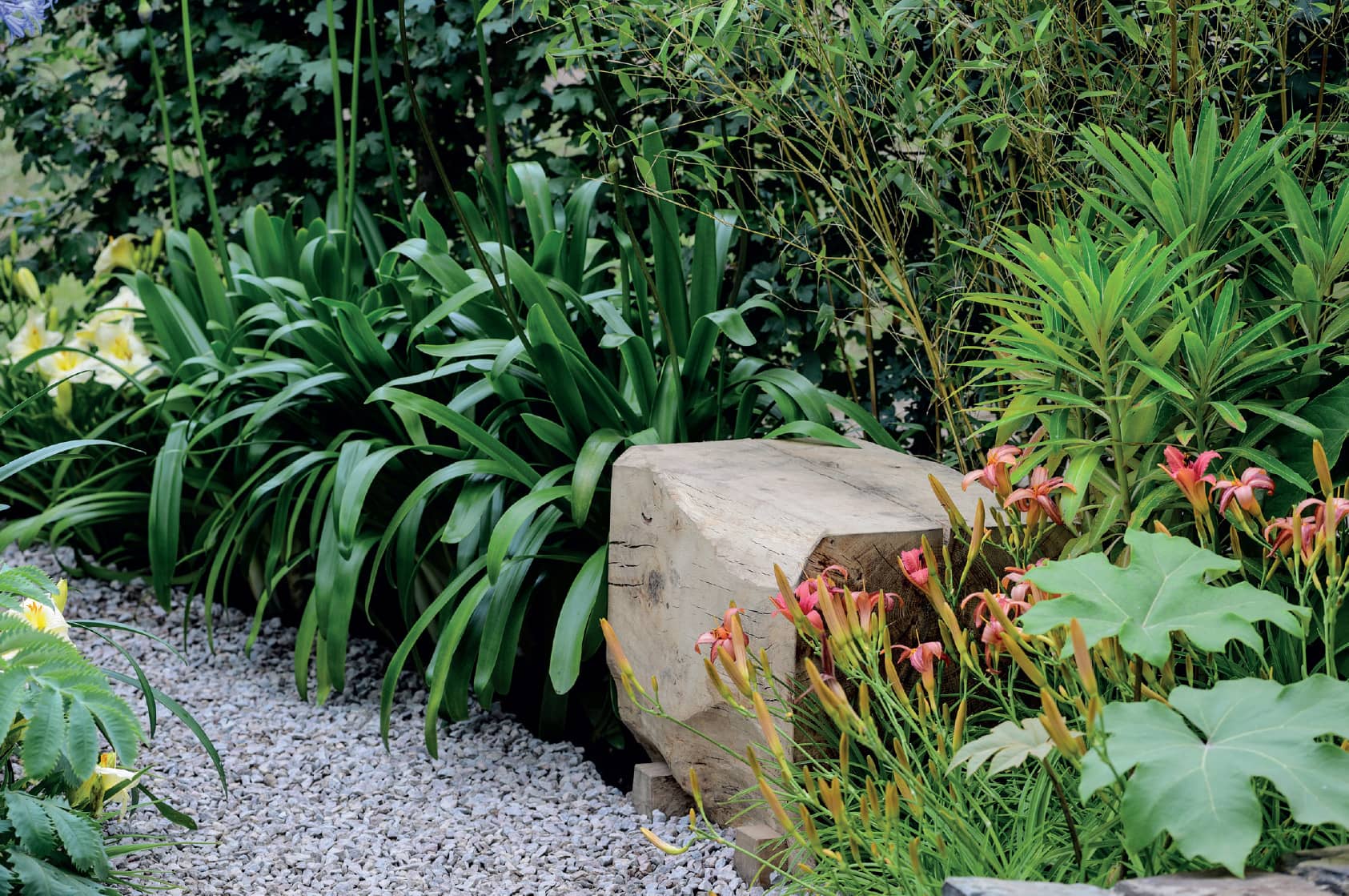
Agapanthus and Euphorbia provide leaf structure and texture in a small modern space.

Red hot pokers (Kniphofia) make an eye-catching addition to a contemporary scheme.
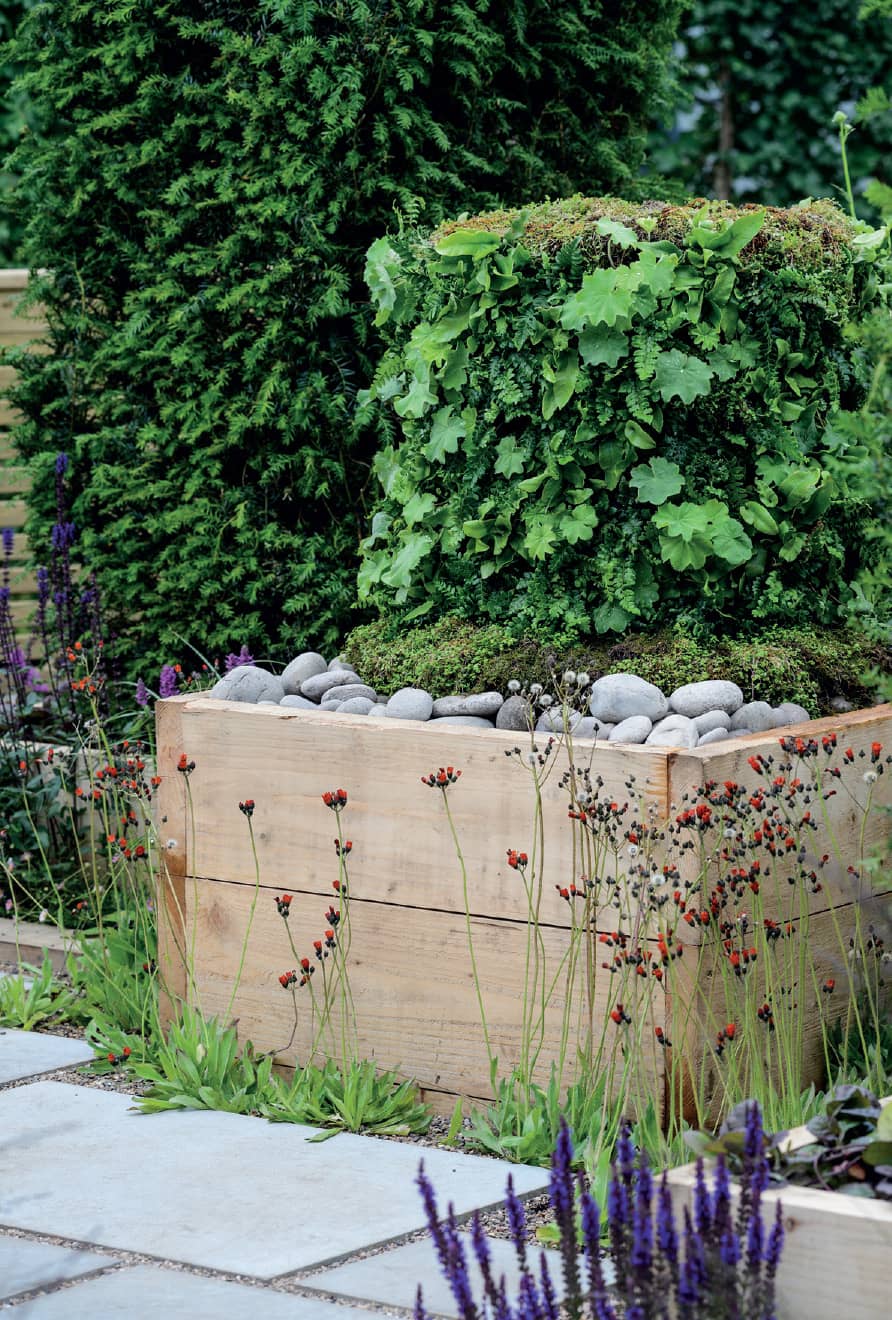
This rectangular timber planter is enhanced by the uniform planting around the edges.